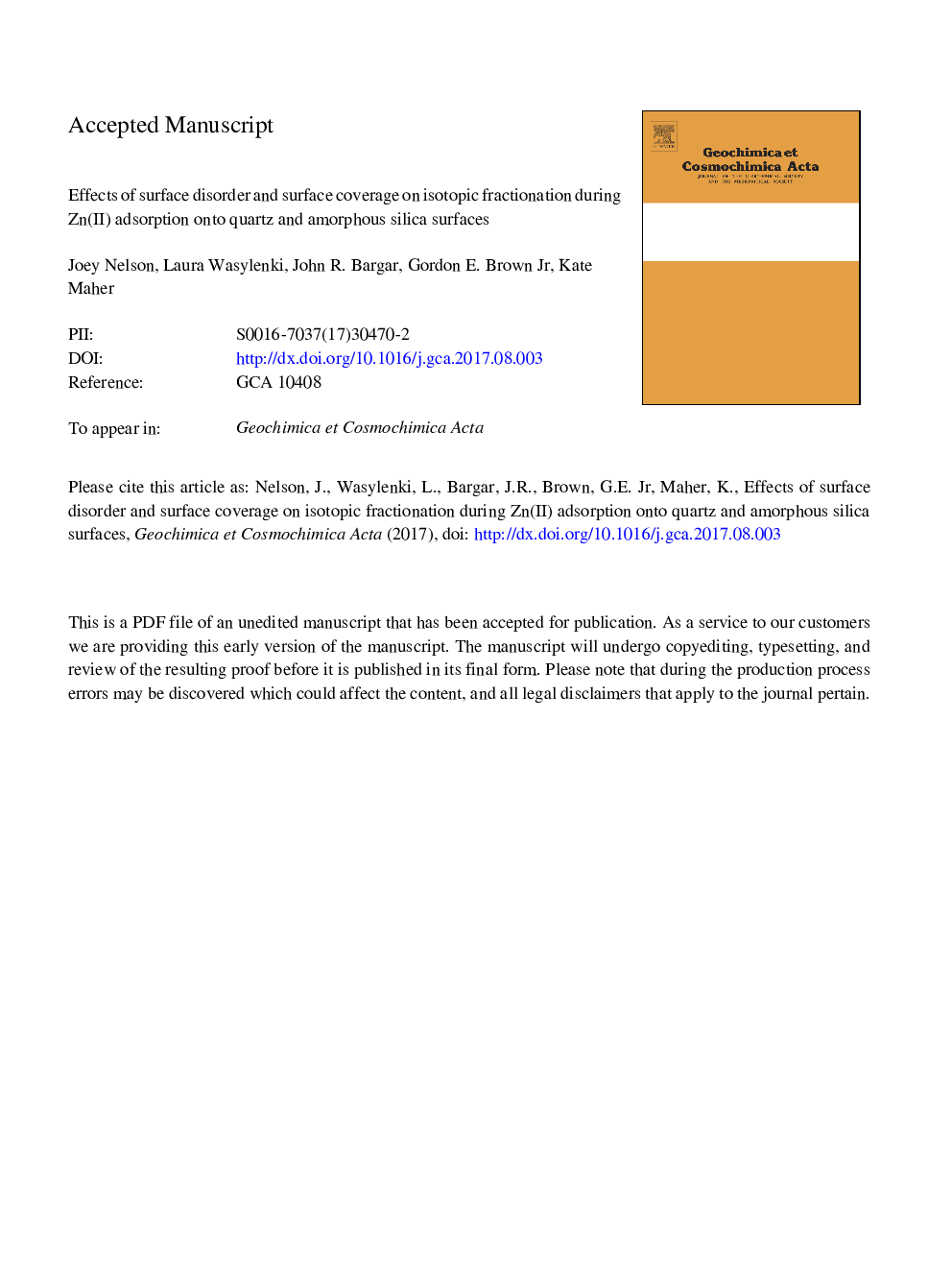| کد مقاله | کد نشریه | سال انتشار | مقاله انگلیسی | نسخه تمام متن |
|---|---|---|---|---|
| 5783249 | 1637942 | 2017 | 58 صفحه PDF | دانلود رایگان |
عنوان انگلیسی مقاله ISI
Effects of surface structural disorder and surface coverage on isotopic fractionation during Zn(II) adsorption onto quartz and amorphous silica surfaces
دانلود مقاله + سفارش ترجمه
دانلود مقاله ISI انگلیسی
رایگان برای ایرانیان
کلمات کلیدی
موضوعات مرتبط
مهندسی و علوم پایه
علوم زمین و سیارات
ژئوشیمی و پترولوژی
پیش نمایش صفحه اول مقاله

چکیده انگلیسی
Metal ion-mineral surface interactions and the attendant isotopic fractionation depend on the properties of the mineral surface and the local atomic-level chemical environment. However, these factors have not been systematically examined for phases of the same composition with different levels of surface disorder. We present pH-dependent adsorption edges, X-ray absorption spectra, and isotopic measurements to illustrate the effects of surface structural disorder and surface coverage on zinc(II) (Zn(II)) surface complexation and isotope fractionation. Our results demonstrate that Zn(II) surface complexes on quartz and amorphous silica (SiO2(am)) transition from octahedral to tetrahedral coordination by oxygen as surface coverage increases. In low ionic strength solutions (I = 0.004 M) and at low surface loadings (Π< 0.6 μmol mâ2), Zn(II) adsorbs to the quartz surface predominantly as outer-sphere octahedral complexes (RZn-O = 2.05 Ã
) with no significant isotopic fractionation (Î66/64Znaqueous-sorbed = â0.01 ± 0.06â°) from aqueous Zn(II). In contrast, under similar chemical conditions and surface loading, outer-sphere Zn(II) adsorption complexes are not observed on SiO2(am) surfaces. At high ionic strength (I = 0.1 M) and low surface loading (Π< 0.2 μmol mâ2), inner-sphere, monodentate octahedral Zn(II) complexes (RZn-O = 2.05-2.07 Ã
) are observed on both quartz and SiO2(am) surfaces. At the same ionic strength (I = 0.1 M) and higher surface loading (Π= 0.6-1.4 μmol mâ2), Zn(II) forms inner-sphere, monodentate tetrahedral complexes (RZn-O = 1.98 Ã
) at the quartz surface. On the SiO2(am) surface under similar chemical conditions and surface loading, Zn(II) forms dominantly inner-sphere, monodentate tetrahedral complexes with shorter ZnO bond distances (RZn-OÂ =Â 1.94Â Ã
). Despite different coordination numbers, the measured equilibrium isotope fractionation factors for inner-sphere octahedral and tetrahedral complexes versus dissolved Zn, under the same conditions and on the same silica substrate, are not distinguishable beyond uncertainties. However, there is a larger measured equilibrium isotope fractionation with preferential sorption of heavy Zn as inner-sphere complexes on SiO2(am) (Î66/64Znaqueous-sorbed = â0.94 ± 0.11â°) than on quartz (Î66/64Znaqueous-sorbed = â0.60 ± 0.11â°).The propensity for Zn(II) to occur in tetrahedral and octahedral coordination with oxygen may help explain these observations. We posit that the low energetic difference between octahedral and tetrahedral Zn(II) may be why changes in inner-sphere Zn(II) coordination numbers with increasing coverage do not manifest as distinguishable isotope fractionations or as an observable alteration to the macroscopic sorption edges. Thus, we attribute the larger magnitude of Zn isotope fractionation on SiO2(am) compared to quartz to differences in the bonding environments on the two types of silica surfaces rather than to a change in the coordination number of Zn(II).
ناشر
Database: Elsevier - ScienceDirect (ساینس دایرکت)
Journal: Geochimica et Cosmochimica Acta - Volume 215, 15 October 2017, Pages 354-376
Journal: Geochimica et Cosmochimica Acta - Volume 215, 15 October 2017, Pages 354-376
نویسندگان
Joey Nelson, Laura Wasylenki, John R. Bargar, Gordon E. Jr., Kate Maher,